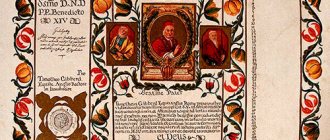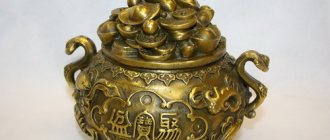From the Last Supper to Mansalvat
The sacred chalice has been shrouded in a mysterious veil for many centuries. We only know that this is a powerful relic that bestows many earthly blessings. It is associated with the first chalice that served Jesus Christ and his apostles when the Last Supper was held.
Some legends say that the Grail is the agate that adorned the crown of Lucifer, which he lost during his fall from heaven.
Find out what awaits you today - Horoscope for today for all zodiac signs
Another legend about the cup says that during the execution of the son of God, the blood flowing down the crucified body was collected in it. This was done by Joseph of Arimathea, who was a Jewish elder and a secret follower of Christ.
The Jews, enraged by Joseph's actions, throw him into prison and forget about him. The sacred vessel supported the unfortunate prisoner for forty-two years, giving him food and preventing him from dying of hunger and thirst. Joseph was freed by Emperor Vespasian, who was cured of leprosy with the help of a shroud with the face of Christ. From this moment the wanderings of the holy vessel begin.
Joseph of Arimathea had a vision in which Jesus instructed him to guard the sacred cup. He hides the Grail in his things and sets off with it to the shores of Britain. Before his death, Joseph entrusts the care of the Grail to his nephew.
Due to numerous requests from readers, we have prepared an “Orthodox Calendar” application for smartphones. Every morning you will receive information about the current day: holidays, fasts, days of remembrance, prayers, parables. Download for free: Orthodox Calendar 2021 (available on Android)
Another legend tells that the sacred vessel was in heaven for a long time, waiting for the time when worthy knights would appear on Earth.
The ancestor of those who had the honor of keeping the famous relic becomes a ruler from Asia - Perillus, who settled in Gaul. Later, his heirs will create marriage alliances with the children of an influential prince.
The pious Titurel, a descendant of Perillus, is entrusted with guarding the sacred vessel. It is he and his faithful knights who are called upon to guard the heavenly cup, in the name of which they erect the castle of Montsalvat. This legend says that the bowl is still located under the arches of the legendary castle.
Numerous legends tell that the Holy Grail provided food and drink to all those who revered and worshiped it. He also healed incurable diseases and could give immortality and eternal youth. The mysterious vessel bestowed enlightenment and spiritual purity on all those who touched it. For many centuries, the Grail has been treated as the most legendary and mysterious relic in the history of mankind.
What did the cup of Christ look like at the last Easter Supper?
So, do we know what the cup that Christ used during the last ritual Easter Supper looked like? Of course not! Indeed, in that era, bowls already had quite a variety of shapes and were made from various materials.
The poor used mainly ceramic dishes. And for some it became a temptation to think that Christ should have had a cup made of clay in his hands, since he was a poor preacher.
But let us remember that the Savior entered the house of the man who gave them a meal in the upper room on Mount Zion.
Zion in Jerusalem was the quarter of the richest people; Jewish nobles lived there. And the Zion Upper Room is located next to the palaces of Herod the Great and the High Priest.
And in the house of a rich man, there was probably rich dishes. It could have been colored glass, or it could have been silver, so beloved by the Israelis of that time. But there could also be stoneware. Yes, yes, exactly stone. The fact is that Jews believe that truly kosher food is only in stone vessels, which only rich religious people could afford.
In some serious reconstructions of the Last Supper, with the participation of authoritative archaeologists, it was assumed that the wine jug was made of stone, and the ritual cup was deep silver, on a low round stand. At the same time, it is not at all necessary that the bread be placed on some kind of tray - most likely, it lay in a stack right on the table among other ritual dishes for the Easter meal.
How the legend was born
The legend about the mysterious cup has long been considered “folk”, and it is quite difficult to trace the beginning of the birth of the legend. However, people who study everything related to the mystical cup do not lose hope. They argue that the search needs to start in medieval Europe. It was there and at that time that a large-scale search for Christian relics unfolded.
At that time, the Roman Church obliges all churches to preserve the remains or belongings of saints. Things related to heirlooms become goods that bring considerable benefits. A great variety of relics, bones and objects allegedly belonging to famous saints are beginning to be brought from eastern countries to European states.
The most valued relics were those related to the passion of Christ. These included:
- parts of the wooden cross on which Christ was crucified;
- Spear of Longinus;
- the nails that nailed Jesus to the cross;
- a small shroud with the face of the son of God and a large one with the imprint of his body;
- crown of thorns
Large feudal lords, high-ranking church officials and even monarchs wanted to take ownership of all this.
When and why did the tradition of giving communion with a spoon arise?
The tradition of taking communion with a spoon, apparently, was not associated with the emergence of any new ideas about personal hygiene. On the contrary: this was how the development of a more respectful attitude towards the Eucharist manifested itself and created convenience with a large influx of people wishing to receive Communion. After all, now there was no longer a need to come up twice for Communion, but everything was served once in full.
In addition, in contrast to the Latin tradition, which focused attention on the suffering and death of Christ, and therefore during Communion, unleavened bread was served, i.e. the bread of sorrow, the symbol of the dead Body, the Eastern Church formed its attitude towards the substances of the Liturgy through theology. For the Churches of the East, the Liturgy became the phenomenon of the Easter Resurrection, and the liturgical bread was “living” - leavened, the bread of joy. It is logical that with such a theology, the Body should be visibly united with the Blood for the faithful as a sign of the restoration of life - the Resurrection. Therefore, the Body began to be immersed in the Chalice and served from there with a spoon.
The spoon for Communion itself was called not “spoon”, “cochlear”, but “labuda”, “pincers” - as a reminder of the hot coal that was put into the mouth of the prophet Isaiah with tongs (Is. 6:7).
It is interesting that the first forms of such spoons resembled real spoons, quite large in size. Until the 18th century, even when the spoons became smaller, they remained deep enough to serve enough Wine and Bread for the communicants.
Liar. 17th century
In the middle of the 12th century, when the custom was still considered an innovation, along with the spoon, another tradition began to appear: drinking from the Chalice using a special silver straw. This custom spread especially quickly in Africa and Spain. But it did not catch on and such tubes became museum rarities already in the 14th century.
I have come across the opinion that such sacramental tubes appeared much earlier and suggest that they could have existed even in the 6th century. Particularly in the Western Church.
Few people know, but in the 4th century a wine strainer was also considered a liturgical object. It was also made from silver or other valuable material and was used to pour wine into the Eucharistic cup.
Treasure of the Zion Monastery: chalices, censers, tabernacle, in the foreground a wine strainer
The fact is that before the Liturgy, Christians brought both their own wine and the bread they had baked. And the wine was often not of the highest quality, and therefore purity. Therefore, a strainer was necessary so that the wine in the bowl would be cleared of impurities.
Along with the cup, a jug was used for the Eucharistic service until the 14th century, and the fresco of the Eucharist in the Athos monastery of Stavronikita makes us understand that in the 16th century on Athos a jug could have been used for Communion.
Thus, the spoon was not at all a ubiquitous object, and the use of the jug suggests communion under two types: Bread and Wine separately.
No bowl
However, among the many sacred objects placed on display by the clergy in the temples, there was no legendary Holy Grail. Its value for church ministers cannot be overestimated. Indeed, according to legend, it was from here that Christ first received communion to his followers during the Last Supper. Given this fact and the importance attached to communion with wine in the Catholic Church, such a vessel became the most desirable relic.
The lack of such an important subject among the clergy was obvious. Various assumptions were made, rumors were spread about the whereabouts of the powerful rarity and its unusual properties.
At that time, the dynasty of French kings was able to collect a huge number of Christian shrines. In contrast to this “success,” Britain puts forward a legend about a sacred vessel and claims that it is located on its territory.
Britain received the right to make such a statement after manuscripts telling about the Grail were discovered. These were two ancient documents that “revealed” the secret.
The Holy Grail may be in Russia
The Grail Cup (or Holy Cup) - this gospel relic is associated in our minds as something mythological, unreal, fabulous. So much has been said and written about the Grail that just listing the works would take a good hundred pages.
The famous Russian traveler, artist, poet Nikolai Konstantinovich Roerich wrote about him, the medieval poet (poet) Chretien de Troyes, the author of the now half-forgotten poem “Perceval, or the Tale of the Grail”, another tireless medieval poet and wanderer Wolfram von Eschenbach worked out the topic most fully gospel relic, devoting 24,810 lines of poetry to it. on his main poem “Parzival” from 1195 – 1216.
The Grail in Western European tradition and medieval legends is a mysterious vessel, in order to approach it and acquire it, knights perform their great feats. The Grail is a cup with the blood of Jesus Christ, which was collected by his secret disciple Joseph of Arimathea, who removed the body of the crucified Jesus. The Holy Grail is served by Christ and the apostles during the Last Supper.
According to other, later versions, the Holy Grail is a silver saucer.
But the life of each of the people drawn into the search for the Gospel relic is excellent material for writing the most exciting adventure novels.
One has only to back up sometimes implausible plots with documentary evidence, and the story of the Holy Grail will sparkle with new and original facets.
Nowadays, the time of information technology, it’s time to remember this medieval legend, since a similar cup was discovered in the city of Krasnodar, after drinking from it, the patient gains health.
The owner of the relic, former officer Igor Podukhevich, is a rational man, never interested in mysticism, and did not believe in the supernatural.
If he calls this “thing” an object of extraterrestrial origin, it means that something has turned upside down in his worldview.
If we ever use the word “extraterrestrial,” it is in an ironic way—as a synonym for the incomprehensible.
Having previously called him by phone, the Armavir local branch of the Russian Geographical Society (RGS) goes to visit him to sort out this whole story on the spot.
The Cup of Life, the healing cup, the gift of aliens - this is also the name of the vessel owned by Krasnodar pensioner Igor Ivanovich Podukhevich.
What kind of artifact is this?
Is it really of extraterrestrial origin, as some scientists claim?
Is it true that water drunk from this cup cures all diseases?
We are sitting in a cozy house, turning a strange thing in our hands. It looks like a wine glass. True, it is somewhat unusual: opaque, ashy in color, with a metallic sheen, the wall is two or three times thicker than usual, the stem is too massive, the profile of the wine glass is uneven - with some kind of annular tides.
Popular articles: Cyrano de Bergerac, Flew Faster than an Airplane
Despite the strangeness of its shape and material, the cup is extremely beautiful. For a household item, this is unreasonably complex and very whimsical.
Many people have seen the cup - it is small, 136 millimeters in height. The maximum diameter is 63 millimeters, wall thickness is 4 millimeters. Capacity - about 75 milliliters. The color is more gray than silver. Shimmers in the sun. On the outer surface there is a pattern reminiscent of frosted glass.
Some see in this pattern the outline of a human face, an alien, and even a ghost (ghost).
-Igor Ivanovich, please tell us how you got this artifact?
I received the cup in 2004 from the hands of my great-grandfather Kirill Kabanov, a nuclear physicist. Before arriving in Krasnodar, he lived in Armavir for a long time. In the 1960s of the last century, he participated in a secret expedition to the Podkamennaya Tunguska River.
I visited the place where the so-called Tunguska meteorite exploded in 1908, felling a forest over an area of several thousand square kilometers. Either a small comet or an asteroid crashed into the Earth.
And according to the hypothesis of the Soviet science fiction writer Alexander Kazantsev, an alien spaceship with a nuclear power plant crashed in the taiga.
Allegedly, it was her traces that the expedition was looking for, in which my ancestor participated as a nuclear physicist. Before his death, the great-grandfather hinted that the cup was directly related to those places and events. He did not specify exactly where and how he was found.
But, handing over the artifact, he meaningfully raised his eyes upward and said: “No one on Earth has this, it’s from there.” My great-grandfather lived to be 102 years old. All the time he drank water only from his cup.
-How did you react to this gift from your ancestor?
I myself, perhaps, would not have remembered my great-grandfather’s gift, but personal grief forced me to. In January 2006, my 16-year-old daughter Ilona was in a car accident.
Doctors gave her the most disappointing diagnoses: rupture of the pancreas, intra-abdominal bleeding, closed fracture of the clavicle with displacement, fracture of the pubic and ischial bones of the pelvis. After several operations, doctors predicted: at best, the girl would stand on crutches. And then not earlier than six months later.
In short, he will remain disabled for life. My daughter was discharged at the beginning of February, and at the end of March we were supposed to come for an examination. And then I decided that in such a situation all means are good.
He began to steep water and broth in a goblet for several hours, as his great-grandfather advised, and gave it to Ilona. And already at the beginning of March my girl started walking! When I arrived at the hospital with her, the doctors couldn’t believe their eyes.
Popular articles: Tibetan amulets. Srung-khor. Review of the most famous souvenirs.
The bones had grown together, the internal organs were in such a condition as if the accident had never happened. But only two months have passed. The doctors could not explain anything, they simply shrugged their shoulders!
-Do you give water to other people to drink from your “magic” cup?
Of course. Those who drink from the cup are cured of various diseases. Get rid of gallstones, hemorrhoids, heartburn, diabetes, headaches, hypertension, severe and minor injuries, gout, obesity, impotence and prostatitis.
Someone who tasted water from the bowl stopped having a heart ache, someone began to read without glasses, although just yesterday he couldn’t see beyond his nose, someone’s terrible cough disappeared as if by hand, a 60-year-old man avoided surgery, and a woman , who was scalded to the bones with boiling water, anointed the burn with magic water - and everything healed.
Miracles, and that’s all! Have you submitted your “mysterious” cup to various scientific institutions for examination? Was your Cup in the hands of scientists?
I contacted several scientific institutions and received amazing results. The cup consists of silicon of extraterrestrial origin, echoes the conclusion issued at Kuban State University (KSU).
The results of the experiment prompted Kuban scientists to such a fantastic conclusion. Allegedly, after the water stood in the cup for 20 hours, the content of molybdenum in it for some mysterious reasons increased by 40 times, copper by 25 times, and zirconium by 10.
And silver, on the contrary, has decreased by 100 times. After thorough material science analyzes carried out in several scientific laboratories, the researchers came to an indisputable conclusion: neither such a chemical composition of the alloy nor such a technology is possible under terrestrial conditions. Here is also the research protocol of the Saratov Forensic Laboratory: the main material of the alloy (over 90%) is pure silicon, the main impurity (more than 5%) is nickel, in addition to it - potassium, nickel, iron, osmium, neodymium, selenium, bromine, phosphorus , cobalt.
X-ray microanalysis done at the Institute of Geology and Mineralogy of the Siberian Branch of the Russian Academy of Sciences confirms the Saratov one to tenths of a percent.
Also, Viktor Panyushkin, a professor at the Department of General and Inorganic Chemistry at Kuban State University, assured me as a specialist that such a ratio of components in the alloy does not occur under terrestrial conditions. And the presence of osmium in an item almost certainly means: this item is from outer space.
Popular Articles: Marconi Zasek Radio Signals Coming from Mars
-Who do you think could have made this “wine glass”?
No less surprising is the analysis of the “wine glass” manufacturing technology. Turning is excluded: under a magnifying glass you can see that the smallest notches are not spiral (as a mark from a cutter would be), but ring-shaped. And practically pure silicon cannot be turned.
Maybe this is a grown crystal?
But why in the shape of a wine glass?
Let’s say this is casting, but there should be traces of the mold, but there aren’t.
In addition, the melting point of the alloy is determined to be 1840 degrees. Of all the detected components, only osmium is higher.
So, no casting. What then? In science, it is not customary to talk about the extraterrestrial origin of an incomprehensible substance.
And such conclusions are not included in the protocols.
But, oddly enough, it is common sense, insists Professor V. Panyushkin, that suggests the only possible solution: this is a product of space technology.
-Have you noticed any other strange things about your “wine glass” or not?
There are other paradoxes as well. I heat water in a “wine glass” in a water bath. So, the water outside the product heats up, as it should when boiling, up to 100 degrees. And the temperature of the water inside the “wine glass”, no matter how much you heat it, never rises above 82 degrees. Physicists have no explanation for this phenomenon. But domestic animals passionately lap up water from the “wine glass” and run after the owner, begging for more. Flowers that were deliberately not watered for a long time begin to bloom in this magical water, contrary to the calendar.
-Do you yourself agree with the conclusions of science regarding your “wine glass” or not?
It’s a pity that our science, panic-strickenly afraid of conclusions that go beyond conventional ideas, shys away from such objects like the plague. All studies of the “wine glass” and the water heated in it, carried out in different cities, were done quietly, on a friendly basis.
And although the conclusions of all those who came into contact with the strange product are fundamentally the same - before us is a product of an extraterrestrial, more developed civilization, it is unlikely that today among prominent scientists there will be anyone who, having summarized the research carried out, will take the liberty of declaring this loudly.
Because such a statement is revolutionary, and revolutions in science are not carried out every hundred years.
Member of the Russian Geographical Society (RGS) of the city of Armavir, Sergey Frolov
Similar
Chronicle of William of Malmesbury and the Grand Saint Grail manuscript
The chronicle tells about the distant year 63 from the Nativity of Christ. At that time, devoted followers of the Apostle Philip arrived in Britain to preach the Christian faith. Preachers led by Joseph of Arimathea erect the first Christian temple on the site where Glastonbury Abbey will eventually be founded. Legends say that it is in this abbey that the body of the famous King Arthur and Queen Guinevere will be found. To this day, there is a source there, which is called the “well of the bowl.”
Another manuscript includes a manuscript dating from the 12th century. It talks about the delivery of the Holy Grail to Britain and the knights who guard the cup. This story was reproduced in their novels by Robert de Boron and Chretien de Troyes, linking their narrative with the legends of the fearless King Arthur.
The British “version” of the appearance of a priceless relic in its vastness gains unprecedented popularity and becomes almost a “medieval bestseller.” In many European countries, similar stories and novels appear that tell new “reliable” details. So the legend spreads and becomes a “historical fact,” arousing more and more interest among many peoples of the world.
About breaking and cutting Bread, or Why did the knife appear?
The knife has been used for cutting and separating bread for quite some time. In Constantinople it was used already from the beginning of the 8th century. Until this time, Bread was only broken. Therefore, when baking, it was deeply cut on top in a cross shape, so that later it would be convenient to break it into the original four parts.
And since Proskomedia (Protesis) took shape quite late, the knife (spear) began to be used there immediately with the custom of using the prosphora not completely, but to cut out the Lamb from the inside. The oldest mention of the antidoron, and therefore the cutting of the Lamb from round bread, can be considered the evidence of the “Explanation on the Liturgy” of Herman of Constantinople according to the list of the 11th century.
On the Ohrid fresco of the 11th century in St. Sophia Cathedral, in the scene of the service of St. Basil the Great, one can see that there is still round bread on the paten. But on the mosaic of the Kiev St. Sophia Cathedral, the image of a knife in the scene of the Eucharist at the holy meal is clearly visible!
Eucharist. Mosaic of Sophia of Kyiv. 11th century
And on the mosaic of the Eucharist of St. Michael's Golden-Domed Monastery (12th century) we can see a knife, a spoon, and an asterisk. However, the star is also visible on the Kiev-Sofia mosaic.
On the fresco of the St. Cyril Church in Kyiv (13th century), a brush for sweeping crumbs from the meal and paten is also noticeable in the Eucharist.
Since the star is mentioned, it should be noted that this liturgical object was definitely known in the 5th century and was discovered in the treasure of the Zion Monastery (6th century) with other vessels. It is interesting that the star was then often attached directly to the paten and made permanent.
Prototype of the Grail
There is another version of why it is in Britain that the legend of the Grail arises as a vessel capable of giving abundance and other benefits. The connection between the Christian Grail and pagan prototypes, which also bestow food, health, gold and knowledge, is examined. Here are just a few examples.
- In Ireland, such mystical properties were given to the Dagda cauldron, from which food and drinks appeared.
- In Britain, such a cornucopia was considered to be a magic cup brought by the powerful Merlin on a crystal ship. This thicket could show the future, reveal sacred knowledge and secrets of the universe.
- Welsh mythology tells of a vessel of wisdom belonging to the goddess Ceridwen. He is told in the History of Taliesin.
- Also in Welsh legends and traditions, another magical thicket is mentioned, which was given to Bran the Blessed by a dwarf from the Lake of the Cup, a witch and a black giant. This vessel healed any fatal disease, healed wounds and raised the dead. The legend of Bran says that the cup subsequently loses its powers. During the battle, Bran the Blessed throws the severed head of his enemy into it, thereby desecrating the purity of the vessel.
All these legends may have formed the basis of the legend about the Holy Grail.
Bowl, dish and stone
The Holy Grail is associated not only with the image of the cup. This is just one image of him among many others. In some Welsh legends, the Grail is identified with a silver dish on which lies a bloody head. This image vaguely resembles the story of John the Baptist.
Eschenbach in Parzival describes the Grail as a stone with unique magical properties and capable of working miracles. According to some versions, the Grail is a container for the blood of Christ, and this is the Virgin Mary. Over time, the number of assumptions and versions only grew, but there was no single idea about such an amazing relic.
What were the liturgical vessels like during the time of the first Christians?
We have a very vague idea of what kind of vessels the Eucharistic offerings were made on during the Supper of Love by the first Christians, but on the catacomb frescoes there is an image of dishes similar to earthenware. It is difficult today to guess whether there are liturgical vessels in these images of sacred symposiums.
Agape. Rome. Catacombs of Domitilla. III century
In fact, the established name of the Eucharistic cup “chalice” tells us not so much about the cup as about the object for drinking. This is exactly how this word is accurately translated from ancient Greek. And therefore it allows for any deep form from which one can drink.
However, historians do not rule out that even in catacomb times, Christians used vessels made of precious metals or made from stones revered by the Romans (onyx, agate, alabaster, porphyry and marble) to serve the Eucharist.
We can say that by the 4th century. The shape of the liturgical cup had already taken shape and became popular: a cup with a high stem. Since the time of the early Christian meetings, the paten (plate) for the Breaking of Bread began to be used. Apparently, it was also made from expensive materials, just like the bowl.
These were sacred objects that were bought together and could serve more than one generation of Christians. They were often hunted by informers during periods of persecution of the followers of the Nazarene - as the only reliable treasure of the community.
Christians have given little thought to the Last Supper as a historical event. They had no need to reconstruct what happened in time. Christ and His Eucharist were always for them a modern event in which they participated - not just in memory, but in anticipation of a genuine meeting with the Teacher. Therefore, what was truly dear to Christians was not the vessels, but their contents: the Body and Blood of Christ. They did not wonder about historical truth, but experienced the joy of real Communion at the Last Supper.
Name
The name of the sacred vessel also remains a mystery. Why was this bowl given such a name? The answer cannot be found in any verified historical document or legend. Therefore, the origin of the word “Grail” remains unknown and gives rise to many theories and conjectures.
According to one version, the name and the legend associated with it are believed to be of Celtic origin. This statement is based on the consonance of the name of the famous bowl and the Irish word cryol, which means “basket of abundance.” Here the semantic load of the word coincides with the magical properties that are attributed to the Holy Grail.
Another version reveals the meaning of the Old French word "sangreal", which translates as "true blood". Another version comes from the word "gratalem", meaning a large vessel in which wine and water are mixed.









